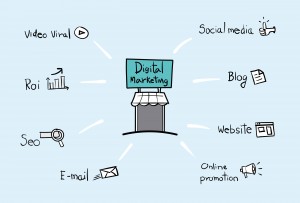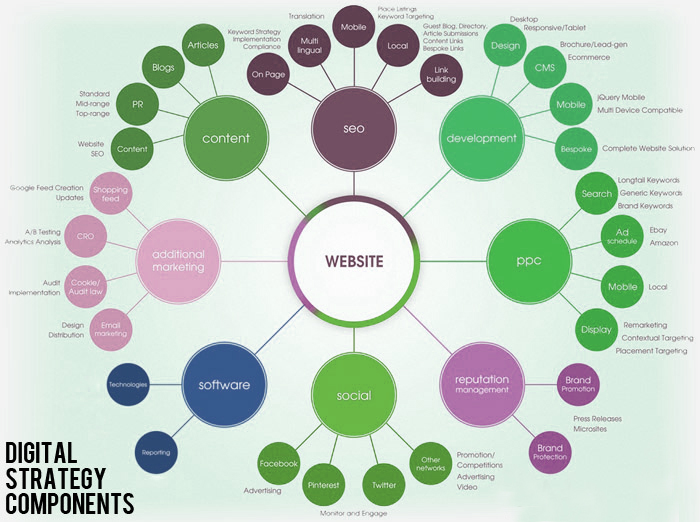Digital marketing, like any form of marketing, has taken its time, albeit, a lot faster than traditional marketing forms to shape up and be a source of leads and revenue. With all types of marketing, going in without a strategy does not pay off, not now, not ever. Digital marketing today demands a strategy that is efficient, effective and easy to change and merge with updates. Mind you, you are never going to get it right the first time, or the second, or the third. That is because the industry is such. Demanding clients, ever changing platforms, new avenues, competition, and the list goes on. So, to stick a digital marketing strategy on its head is no easy task. There are a few things that you could do to make life easier for your marketing team. Be prepared for loads of research, analysis, budget allocations and the usual, ‘why isn’t this working?’ question from the management.
Digital marketing strategy-Out with the old, in with the new
Tried and tested marketing strategies may seem as the easier escape for someone looking to start from scratch. Why wouldn’t they since they have been around for decades, stood the test of time and have in-fact given results too. NO. Old methods, practices and roles do not go well with the digital marketing scenario. As far as business strategies and programs are concerned, they have a tendency to lean towards the long term. This does not hold good for digital marketing. The simple reason is that digital marketing is way too fluid, aggressive and ever changing to have hard and fast rules and parameters to stick to.
So what do you do? Don’t consider your digital marketing strategy as something that will eventually lead to massive business volumes. It’s your sales team that will do it for you. Now, if you come to think of it as a branding and lead generation platform, digital marketing is your answer. Generating leads on digital platforms is the way to go and your strategy should be clear about this. No wonder the old business tactics of setting 4-5 year goals goes out the window when you see a dramatic shift in your customer base and their needs. Throw in some competition and you are stuck on a boat with no oars.
Your digital marketing strategy should focus on the flow of your marketing message to the focus group of prospects. Surrounding this will be your resources, content creation and promotion policies. As a digital marketing agency ourselves, after working with over 300 companies worldwide, one thing we have learnt for sure is assigning the right people for the right roles makes a lot of difference.
The right people to take the right call
Everyone has an opinion. It does not mean it is always the right one. Assigning people who can take the right decisions and allowing those decisions to be final and putting them to work allows for faster development and deployment of your marketing messages. If a content writer has an opinion about the design, it should be considered, but the final call about the design should and will always be with the designer. It is all too common to see the CEO or the CMO meddling with the marketing message, putting out their years of experience and their thought process into the mix. This should not affect the decision making process but should add to the mix in a constructive manner.
Most companies grapple with resource crunch. During such times, it is wise to think of outsourcing, be it partly or full project outsourcing. Now when outsourcing, working with an external marketing agency creates friction and they will have their own set of tendencies. It is paramount to understand that it takes a decent amount of time to work well with an external agency. All the shortcomings have to unravel by themselves and changes have to be made on the go. To minimize the stress, the agency can always take it further by creating a responsibility process that clarifies who does what and when.
LOOKING FOR A DIGITAL MARKETING STRATEGY-CLICK HERE
Best practices, guides and policies
Since it is a digital marketing scenario, your website is your window to the world. There are numerous factors that can be changed, modified and added to an online resource. Creating strict guidelines as to these factors is your road map to consistency, alignment and brand stability. Create documents or guides that give clear messages about what can be done and more importantly, what cannot be done. Design guidelines, content calendars and writing style, coding patterns and hosting and last but not the least, disaster management. Most companies do not have this crucial aspect in their digital marketing strategy and let’s be assured of one thing, at some point or the other-a disaster will strike! This is when the contingency plan has to be put into place and this will allow for the issue to resolve peacefully without creating unnecessary drama inside your company, rifts and issues.
Most agencies get side tracked in their work when clients decide that something is urgent and important and impose themselves. This can be done away with by having specific priority guidelines that lets you decide if it is worth setting off other work and focusing on ad-hoc requests. Finally, results matter and when reports are in, was the focus shift necessary and did it bring in results or did it hamper work? To make away with these, your digital marketing strategy should have these parameters checked.
Don’t spread yourself thin- prioritize your channels
Digital marketing incorporates various channels. It is wise to ensure that you prioritize each one according to your digital marketing requirement. Every business has its own set of needs. These needs have to be aligned to the channel. Some channels work well for certain types of business and some do not. For example, for a B2C company that retails t-shirts, they have a strong reason to be aggressive on social media platforms, the favorable platform for the new generation of digitally connected youth. For a B2B concern that sells medical equipment that has their prospect base in bulk buyers and hospital networks, email marketing is their strong point as businesses tend to run on email for larger orders. It is proof enough to make you take this step and ensure that your digital marketing strategy takes this into account.
There are some channels that essentially need to be part of the mix, always, but prioritizing which one gets attention on a daily, weekly and monthly basis is purely based on your product, the demographic you cater to and the size of business you are looking to capture.
Website– It needs to be of top priority, irrespective of your business. This is where your prospect will eventually land and your business process unfolds. The design and development should also be on the lines of your business, so if you are looking to attract the younger generation, it is essential to concentrate on the design, a lot more than the actual content of the site. For B2B spaces, content trumps anything and everything as buyers of high value commodities read on average a lot more than small purchasers.
Mobile-mobile is blowing up and everyone with purchasing power is online, through their mobile. Having a mobile ready website is not important; it is unavoidable today due to Google algorithm changes. Apps and online payment gateways seem to be overtaking the world and the best thing to do is have a presence, but not to overdo it depending on your business and demographic type.
Email marketing- the average email ROI is $24 per email. This is a massive number and shows the immense power it has. It is imperative to ensure you have an email campaign working, at least for branding purposes, if not for lead generation.
Social media– the most powerful digital platforms today, social media is essential to your digital marketing strategy. There are certain aspects of social media that you need to take care of. Certain businesses have a lot more success on certain platforms when compared to others. Do research on competitors and the industry in particular and understand where the focus is on. Replicate this. This also does not mean that it will work or wont for you. Your content creation, timing and spending on the platforms also play a significant role in this.
SEO and SEM– these are essential for any business today. They need a presence but understanding the scope of these tools as per your industry and product will give you an idea of how much you need to invest and where.
Creating a digital marketing strategy requires time, effort, an in-depth knowledge of the business, product, industry and your target audience. It also requires a keen knowledge of the various digital marketing platforms, their strong and weak points and how they can be used as per your situation. No digital marketing strategy is easy to create and put it to work; it is a fluid, flexible plan that requires constant changes and tweaks. Always be prepared for the worst and you will do well when the situation is conducive.
Picture credit-AS Acumen Studio


